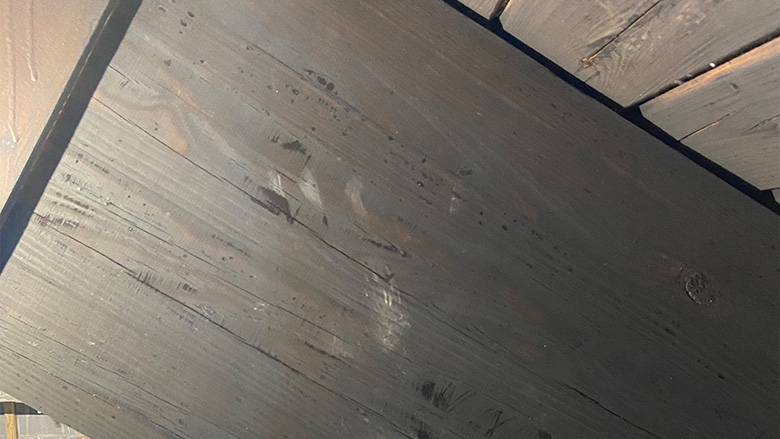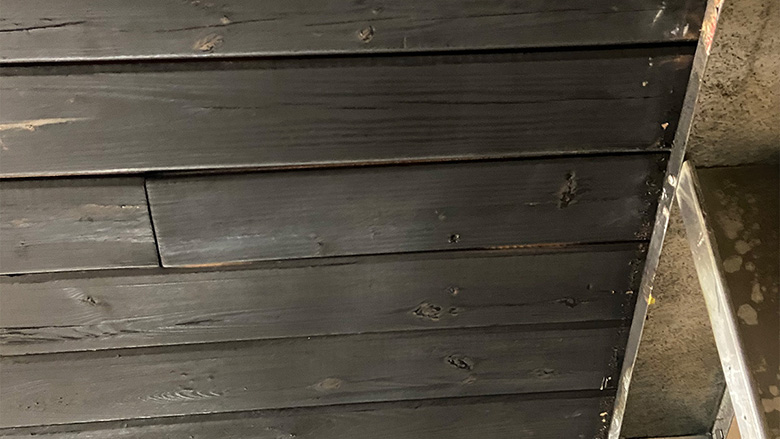Dry Ice Blasting for Faster Fire Restoration Cleaning with Less Mess

All photos credit: Jennifer Kelm Sergio
Restoration professionals work in an industry with plenty of built-in challenges.
From stressed customers to long hours, demanding expectations and grueling physical labor, it’s a job that comes with a high rate of burnout even before you throw in the rising cost of materials, labor shortages and supply chain backlogs that made 2022 such a treat for the margins.
As Al Scott, president of First Response Disaster Restoration Specialists in South Bend, Indiana said, “We’re all singing the same song now. Everybody is asked to do more for less and you can only squeeze that pipeline so much.”
Against that backdrop – and the return of fire season – it’s a good time to explore options for saving labor on the job. Dry ice blasting is a good example of a tool that, while it has been around for 20 years, is often overlooked as a method for quickly and effectively removing soot, char and odor from the surface of many fire-affected surfaces, without the residual clean-up of debris that other blasting methods introduce.
Here’s an overview of how it works, some of the best applications for using it, and a few examples of fire restoration projects where dry ice blasting lived up to its growing reputation for tackling complex jobs with speed, effectiveness and efficiency.
A Fiery Hate Crime and a Delicate Ceiling Restoration
Churchgoers at the Queen of Peace Catholic Church in Ocala, Florida, escaped without injury after a disturbed young man splashed 10 gallons of gasoline into the foyer and ignited it in July 2020. But the fire left the building with extensive damage that included a heavy coating of soot and char across the structure’s tongue-and-groove pine cathedral ceiling.
Extreme heat generated by the fire had caused tiny pores in the wood to open and fill with carbon residue, which could have left the wood permanently blackened.
Ordinary blasting methods posed a risk of damage to the elaborately constructed ceiling, while replacement carried a price tag estimated at over $1 million.
Luckily, the national restoration company professionals on the job were familiar with the capabilities of dry ice blasting, which uses frozen CO2 pellets to deliver a blast of varying size and pressure to remove a wide array of coating and adherents.
Joseph Sergio, partner and founder of Polar Clean, the South Bend, Indiana, dry ice blasting company hired by the restoration company to clean the ceiling, said the success of such efforts requires a careful selection of pressure, nozzle type and dwell time to avoid over-blasting a soft surface like pine.

For the church ceiling, the Polar Clean team used extensive scaffolding and sample cleaning of two-foot sections to calibrate the right approach.
“You can’t just get in there and blast away,” Sergio said.
Too much pressure, or the wrong type of ice, nozzles or equipment or over-blasting can mar the wood surface and damage parts like trusses. In areas where deeply adhered soot required extra blasting, the team was able to “feather” the blast across sections to ensure a natural and seamless pattern across the grain.
Within a week, dry ice blasting had restored the wood to its original beauty, at a substantial cost savings to the church.

As Sergio explains, dry ice blasting was the right solution, with benefits for fire restoration that include:
- No residual debris to clean up: dry ice blasting uses no water, creates no abrasive mess, and the pellets sublimate on contact
- Non-chemical, non-toxic
- Customizable force that can be adjusted to a light dusting for delicate areas
- Safe for a wide variety of surfaces, including brick, masonry, limestone, wood and metal
- Non-flammable and non-conductive equipment
- Significantly faster than other abrasive cleaning methods
- Safe for use on or around equipment, wiring and electrical components
- Effective for removal of smoke-damaged batted insulation
Twin Fires at Indiana Apartment Complex and the Time-saving Relief of Dry Ice
When an electrical fire left a 12-unit apartment building in southern Indiana badly damaged in 2021, Louisville, Kentucky-based PuroFirst Disaster Services was brought in to manage restoration. With 28 years of experience in disaster restoration, much of it fire related, the family-owned business has seen every kind of bad luck. This was the déjà vu kind.
According to PuroFirst chief operating officer Chase Hunter, restoration of one side of the building following an electrical fire was interrupted by a second fire on the opposite side of the building where another company was doing unrelated pipe work and a soldering ember dropped between floors.
Much of the completed fire restoration work had to be repeated as the building was once again engulfed in smoke, soot and water.
Hunter, who said his company has been using dry ice blasting in fire restoration settings for “at least 10 years,” described the resulting mess as a “perfect example” of a scenario where dry ice blasting is a good fit.
The reasons included the amount of soot-covered structural framing, and the number of smaller areas affected, including floor joist cavities, trusses and ceiling joists.
“A lot of little nooks and crannies,” he said. Other media types “create such a mess with the cleanup. The dry ice basically evaporates in the air.”
Hunter said while another blasting type he priced was cheaper, “the additional labor to prep and clean up was, I think, roughly 25% more.”
The project, he said, was a “pretty standard use” of dry ice blasting for PuroFirst, as part of a three-part process that includes:
- Cleaning surfaces of any standing soot
- Deodorizing the building with ozone, a thermal fogger, or hydroxyls
- Encapsulating the cleaned areas with a sealer over all porous surfaces
For the apartment complex project, dry ice blasting delivered added time savings as well.
“It pretty well performed as expected. We were pleased and we came in like two days under schedule. It went a little quicker than we thought.”
Hunter said he also prefers dry ice blasting for framing and masonry cleaning. “The efficiency of hand cleaning with those types of surfaces is a really low production rate,” he said.
Post-fire Dry Ice Cleaning for RV Painting Facilits
For Scott of First Response, two key factors in the decision of whether to use dry ice blasting in fire restoration are the amount of char and the size of the area involved.
“Normally you would need a fairly large area to make it cost effective,” he said. “We use it in a lot of industrial applications. Warehouses, I-beams, metal ceilings – that’s a good application with wide open space where you can methodically move back and forth over large areas.”
As an example, he cited his company’s work in a recreational vehicle painting facility where a smoky fire had left I-beams, the underside of a metal ceiling and concrete walls heavily coated in soot. Dry ice blasting was fast, effective, and required less labor than the alternatives of hand cleaning or another form of blasting that would have required additional cleanup.
Other Industrial Fire Application
After an oven fire at a Midwestern food manufacturing facility, dry ice blasting was used to remove soot and debris from ceiling joists and other overhead structures, Sergio said.
Because of the risk of added debris that other blasting methods pose, dry ice blasting is often used in food production settings, where hand cleaning is often the only alternative. Because it uses no water and can be applied in a “feathering” blast, dry ice cleaning can also be used to remove soot and char from delicate equipment and electrical components, he said.
When Not to Use Dry Ice Blasting
Dry ice blasting is not the right solution for every application in the fire restoration setting, however.
Unsuitable applications can include:
- Drywall
- Small spaces where dry ice blasting is not cost-effective
- Plaster
- Asbestos pipe covering
- Structurally damaged surfaces
- Surfaces where stubborn adherents require a more aggressive blasting method
On the other hand, when dry ice blasting is a good option, it can be a game changer in terms of labor savings.
“I think really… the biggest thing that always sells us on dry ice blasting is the efficiency,” said Hunter. “The other media are just as effective … but a lot of additional labor.”
Looking for a reprint of this article?
From high-res PDFs to custom plaques, order your copy today!







